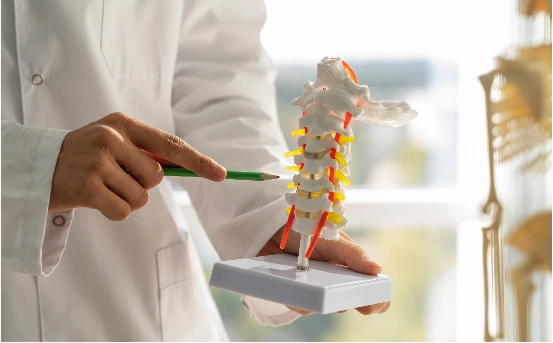Types of discectomy surgery is a common procedure used to relieve pressure on spinal nerves caused by a herniated or damaged intervertebral disc. If you or a loved one is suffering from debilitating back pain, sciatica, or nerve compression, understanding the different types of discectomy surgery is essential to making an informed treatment decision.
Back pain is one of the most common medical complaints worldwide, affecting millions of people across all age groups. In many cases, the root cause of chronic back or neck pain can be traced to a herniated or slipped disc a condition where the soft inner portion of a spinal disc pushes through a crack in the tougher exterior. When this displaced disc material compresses nearby spinal nerves, it can lead to severe discomfort, radiating pain, numbness, tingling sensations, and even weakness in the limbs.
What Is Discectomy Surgery?
A discectomy is a surgical procedure that involves removing the damaged portion of a herniated disc in the spine. When a disc bulges or ruptures, it can press against nearby nerves, causing pain, numbness, tingling, or weakness—usually in the back, legs, or arms. Discectomy aims to relieve these symptoms by alleviating nerve compression.
Discectomy can be performed at any level of the spine—cervical (neck), thoracic (mid-back), or lumbar (lower back) depending on where the herniation is located.
Who Needs a Discectomy?
Doctors usually recommend discectomy surgery when :-
-
Conservative treatments like rest, physical therapy, or medications have failed
-
Symptoms like numbness, weakness, or pain worsen over time
-
There is difficulty walking or loss of bowel/bladder control (a medical emergency)
Types of Discectomy Surgery
There are several approaches to discectomy surgery, each with its own advantages, techniques, and indications. Let’s explore the most common types:
Open Discectomy
Overview :-
Open discectomy is the traditional method where the surgeon makes a small incision in the back to access the spine and remove the herniated disc material.
How It’s Done :-
-
Performed under general anesthesia
-
A small portion of bone (lamina) may be removed to access the disc (laminotomy or laminectomy)
-
The affected disc material is removed with surgical tools
Best For :-
-
Large disc herniations
-
Patients who require direct visualization during surgery
Pros :-
-
Time-tested and effective
-
Suitable for complicated or extensive disc problems
Cons :-
-
Longer recovery time
-
Larger incision and more muscle disruption
Microdiscectomy
Overview :-
Microdiscectomy is a minimally invasive version of open discectomy using a microscope or surgical loupe to enhance visualization.
How It’s Done :-
-
A small incision (about 1 inch) is made
-
Muscles are gently retracted, not cut
-
A microscope helps guide precise removal of disc material
Best For :-
-
Lumbar disc herniation
-
Sciatica due to nerve root compression
Pros :-
-
Shorter recovery
-
Less pain post-surgery
-
Smaller scar and reduced blood loss
Cons :-
-
Limited visibility in complex cases
-
May not be suitable for recurrent herniations
Endoscopic Discectomy
Overview :-
An advanced minimally invasive procedure, endoscopic discectomy uses a tiny endoscope (camera) and specialized instruments inserted through a very small incision.
How It’s Done :-
-
Performed under local or general anesthesia
-
A thin tube is inserted through a small (8 mm) incision
-
Real-time video guidance helps remove herniated disc fragments
Best For :-
-
Mild to moderate disc herniation
-
Patients who prefer outpatient or same-day surgery
Pros :-
-
Minimal tissue damage
-
Faster return to daily activities
-
Often performed under local anesthesia
Cons :-
-
Requires high surgical expertise
-
Not suitable for all types of herniations
Percutaneous Discectomy
Overview :-
Percutaneous discectomy is a non-surgical or minimally invasive procedure that uses imaging guidance to insert a probe through the skin to remove disc material.
How It’s Done :-
-
Local anesthesia is used
-
A needle-like probe is guided into the disc
-
Laser or suction technology removes or shrinks disc tissue
Best For :-
-
Contained disc herniations (not ruptured)
-
Early-stage disc degeneration
Pros :-
-
Very short recovery time
-
No large incisions
-
Low risk of infection
Cons :-
-
Less effective for large or migrated disc fragments
-
May require repeat treatment
Anterior Cervical Discectomy and Fusion (ACDF)
Overview :-
ACDF is a specialized discectomy performed on the cervical spine (neck). It involves removing a herniated disc from the front (anterior) of the neck and then fusing the vertebrae.
How It’s Done :-
-
Small incision in the front of the neck
-
Damaged disc is removed
-
A bone graft or spacer is inserted
-
Fusion hardware (plates/screws) may be used
Best For :-
-
Cervical disc herniation
-
Spinal instability in the neck
Pros :-
-
High success rates
-
Stabilizes spine after disc removal
Cons :-
-
Longer recovery than endoscopic techniques
-
Reduced flexibility at the fused segment
Recovery After Discectomy Surgery
Recovery time depends on the type of discectomy performed:
-
Open discectomy :- 4–6 weeks
-
Microdiscectomy :- 2–4 weeks
-
Endoscopic discectomy :- 1–2 weeks
-
Percutaneous discectomy :- Few days to 1 week
-
ACDF :- 6–12 weeks (longer if fusion is involved)
Most patients experience significant pain relief shortly after surgery. Physical therapy is often recommended to restore strength and flexibility.
Risks and Complications
While discectomy is generally safe, all surgical procedures carry some risks. These may include :-
-
Infection
-
Bleeding
-
Nerve injury
-
Recurrence of disc herniation
-
Spinal instability
-
Reaction to anesthesia
Choosing an experienced spine surgeon and a well-equipped hospital significantly reduces these risks.
How to Choose the Right Type of Discectomy?
The appropriate type of discectomy depends on several factors :-
-
Location and size of herniation
-
Severity of symptoms
-
Age and overall health
-
Previous spinal surgeries
-
Surgeon’s expertise and available technology
Your spine specialist will assess your MRI or CT scan results and recommend the most suitable surgical option.
Conclusion
Living with chronic back or neck pain due to a herniated disc can severely affect your quality of life. Fortunately, advancements in spinal surgery have made discectomy procedures safer, less invasive, and more effective than ever before.























